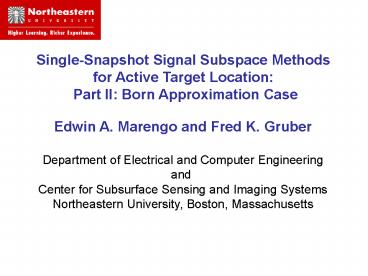TimeReversed Electromagnetics: Generalized SourceInversion and Imaging PowerPoint PPT Presentation
1 / 34
Title: TimeReversed Electromagnetics: Generalized SourceInversion and Imaging
1
Single-Snapshot Signal Subspace Methods for
Active Target Location Part II Born
Approximation Case
Edwin A. Marengo and Fred K. Gruber Department
of Electrical and Computer Engineering and
Center for Subsurface Sensing and Imaging
Systems Northeastern University, Boston,
Massachusetts
2
Problem and System Description
known background medium
unknown clutter
target(s)
receivers
transmitters
New method High-dimensional signal subspace
method.
Maximum Likelihood (ML) estimator under the Born
approximation if one seeks target positions and
their reflectivities (scattering potential
function).
3
Problem and System Description
known background medium
unknown clutter
target(s)
receivers
transmitters
New method High-dimensional signal subspace
method.
Maximum Likelihood (ML) estimator even under
multiple scattering conditions if nuisance
parameter is the two-point scattering potential
matrix or tensor (not the usual one-point
scattering potential function).
4
Problem and System Description
known background medium
Reciprocal medium
unknown clutter
target(s)
transmitters
receivers
Special case of
5
Problem and System Description
known background medium
Time-reversal approach
Reciprocal medium
unknown clutter
target(s)
transmitters
receivers
Special case of
Multiply scattering as well as non-multiply
scattering, Born-approximable targets.
6
Number of Localizable Targets
Same for non-Born-approximable targets.
7
Number of Localizable Targets
Same for non-Born-approximable targets.
For Born-approximable targets,
(coincident array of N elements)
(non-coincident array of N transmitters and
receivers)
8
Forward Mapping Under Multiple Scattering
M2 terms
Scattering potential matrix
9
Forward Mapping Under Born
- M expansion terms only
Contraction of object space dimensionality for
same data space dimensionality.
10
ML/High-Dimensional Signal Subspace Method Born
Approximation
11
ML/High-Dimensional Signal Subspace Method Born
Approximation
12
ML/High-Dimensional Signal Subspace Method Born
Approximation
Assume
13
ML/High-Dimensional Signal Subspace Method Born
Approximation
S
- Data are not arbitrary, i.e., S Span (?m)
14
ML/High-Dimensional Signal Subspace Method Born
Approximation
N
S
S0
- Data are not arbitrary, i.e., S Span (?m)
- Assume Q and consequently hypothesized
propagators - spanning a hypothesized (conditional) signal
space S0. - Compute orthogonal complement of S0 ( N)
15
ML/High-Dimensional Signal Subspace Method Born
Approximation
N
S
SS0
- Data are not arbitrary, i.e., S Span (?m)
- Assume Q and consequently hypothesized
propagators - spanning a hypothesized (conditional) signal
space S0. - Compute orthogonal complement of S0 ( N)
- Project the data onto N.
- Pick Q that minimizes this projection.
Under additive spatially white Gaussian noise,
this is the ML estimator.
16
Multiple Scattering Case
M2 terms
Scattering potential matrix
Same But it involves M2 propagators per M
targets.
17
Number of Localizable Targets
Same for non-Born-approximable targets.
For Born-approximable targets,
(coincident array of N elements)
(non-coincident array of N transmitters and
receivers)
18
Computer Simulation Examples
transmitters
receivers
two targets
19
ML/High-Dimensional Signal Subspace Method
20
Projections Onto the Principal Axes of the
ML/High-Dimensional Signal Subspace Spectra
21
Time-Reversal MUSIC Pseudospectrum
22
Time-Reversal MUSIC Pseudospectrum Parameterized
by the Y Coordinate
23
Time-Reversal MUSIC Pseudospectrum
30 dB SNR
24
ML/High-Dimensional Signal Subspace Method
Spectrum
30 dB SNR
For Y-4
25
Target Position Estimation Error Vs SNR
Single target
Tx Rx TR MUSIC
CRB
ML
26
Target Position Estimation Error Vs SNR
Single target
(Far Zone)
27
Two Targets (Target 1 Position Estimation)
Multiple Scattering
28
Two Targets (Target 2 Position Estimation)
Multiple Scattering
29
Two Targets (Target 1 Position Estimation)
Born
30
Two Targets (Target 2 Position Estimation)
Born
31
(No Transcript)
32
Three Antennas Locate Three Far Field Targets
33
Assuming Two Targets Only
34
Conclusion
- Time-reversal MUSIC for active target location
- under multiple scattering conditions.
- High-dimensional signal subspace method
- outperforms the time-reversal approach, at
- computational expense.
- In Born case, enables more localizable targets.
- Applications involving few antennas and targets.
- Under AWGN, it is ML estimation.
- CRB.
- E.A. Marengo and F.K. Gruber, IEEE Trans.
- Antennas Propagat., in review (2005).

